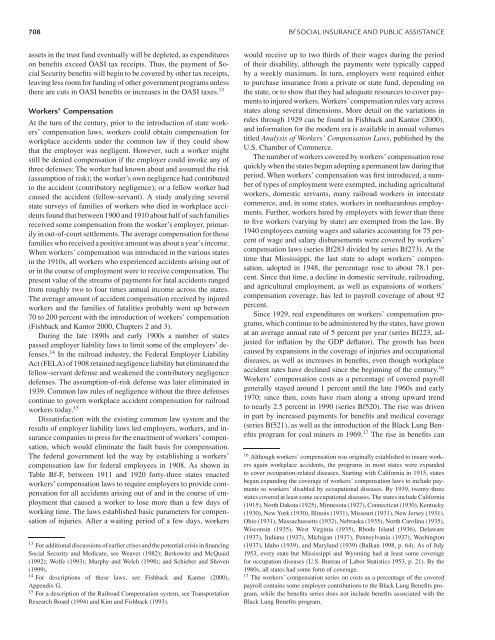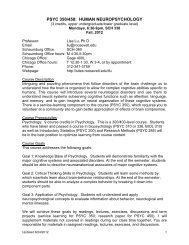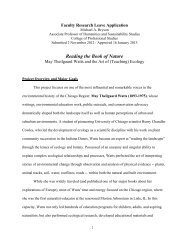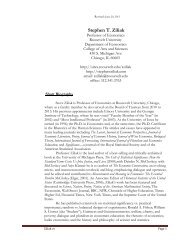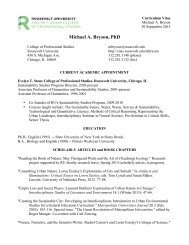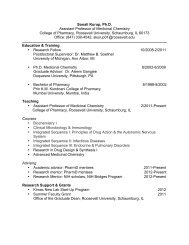Social Insurance and Public Assistance
public-assistance-welfare-reform-colonial-times-to-the-present-ziliak ...
public-assistance-welfare-reform-colonial-times-to-the-present-ziliak ...
You also want an ePaper? Increase the reach of your titles
YUMPU automatically turns print PDFs into web optimized ePapers that Google loves.
708 Bf SOCIAL INSURANCE AND PUBLIC ASSISTANCE<br />
assets in the trust fund eventually will be depleted, as expenditures<br />
on benefits exceed OASI tax receipts. Thus, the payment of <strong>Social</strong><br />
Security benefits will begin to be covered by other tax receipts,<br />
leaving less room for funding of other government programs unless<br />
there are cuts in OASI benefits or increases in the OASI taxes. 13<br />
Workers’ Compensation<br />
At the turn of the century, prior to the introduction of state workers’<br />
compensation laws, workers could obtain compensation for<br />
workplace accidents under the common law if they could show<br />
that the employer was negligent. However, such a worker might<br />
still be denied compensation if the employer could invoke any of<br />
three defenses: The worker had known about <strong>and</strong> assumed the risk<br />
(assumption of risk); the worker’s own negligence had contributed<br />
to the accident (contributory negligence); or a fellow worker had<br />
caused the accident (fellow-servant). A study analyzing several<br />
state surveys of families of workers who died in workplace accidents<br />
found that between 1900 <strong>and</strong> 1910 about half of such families<br />
received some compensation from the worker’s employer, primarily<br />
in out-of-court settlements. The average compensation for those<br />
families who received a positive amount was about a year’s income.<br />
When workers’ compensation was introduced in the various states<br />
in the 1910s, all workers who experienced accidents arising out of<br />
or in the course of employment were to receive compensation. The<br />
present value of the streams of payments for fatal accidents ranged<br />
from roughly two to four times annual income across the states.<br />
The average amount of accident compensation received by injured<br />
workers <strong>and</strong> the families of fatalities probably went up between<br />
70 to 200 percent with the introduction of workers’ compensation<br />
(Fishback <strong>and</strong> Kantor 2000, Chapters 2 <strong>and</strong> 3).<br />
During the late 1890s <strong>and</strong> early 1900s a number of states<br />
passed employer liability laws to limit some of the employers’ defenses.<br />
14 In the railroad industry, the Federal Employer Liability<br />
Act (FELA) of 1908 retained negligence liability but eliminated the<br />
fellow-servant defense <strong>and</strong> weakened the contributory negligence<br />
defenses. The assumption-of-risk defense was later eliminated in<br />
1939. Common law rules of negligence without the three defenses<br />
continue to govern workplace accident compensation for railroad<br />
workers today. 15<br />
Dissatisfaction with the existing common law system <strong>and</strong> the<br />
results of employer liability laws led employers, workers, <strong>and</strong> insurance<br />
companies to press for the enactment of workers’ compensation,<br />
which would eliminate the fault basis for compensation.<br />
The federal government led the way by establishing a workers’<br />
compensation law for federal employees in 1908. As shown in<br />
Table Bf-F, between 1911 <strong>and</strong> 1920 forty-three states enacted<br />
workers’ compensation laws to require employers to provide compensation<br />
for all accidents arising out of <strong>and</strong> in the course of employment<br />
that caused a worker to lose more than a few days of<br />
working time. The laws established basic parameters for compensation<br />
of injuries. After a waiting period of a few days, workers<br />
13 For additional discussions of earlier crises <strong>and</strong> the potential crisis in financing<br />
<strong>Social</strong> Security <strong>and</strong> Medicare, see Weaver (1982); Berkowitz <strong>and</strong> McQuaid<br />
(1992); Wolfe (1993); Murphy <strong>and</strong> Welch (1998); <strong>and</strong> Schieber <strong>and</strong> Shoven<br />
(1999).<br />
14 For descriptions of these laws, see Fishback <strong>and</strong> Kantor (2000),<br />
Appendix G.<br />
15 For adescription of the Railroad Compensation system, see Transportation<br />
Research Board (1994) <strong>and</strong> Kim <strong>and</strong> Fishback (1993).<br />
would receive up to two thirds of their wages during the period<br />
of their disability, although the payments were typically capped<br />
by a weekly maximum. In turn, employers were required either<br />
to purchase insurance from a private or state fund, depending on<br />
the state, or to show that they had adequate resources to cover payments<br />
to injured workers. Workers’ compensation rules vary across<br />
states along several dimensions. More detail on the variations in<br />
rules through 1929 can be found in Fishback <strong>and</strong> Kantor (2000),<br />
<strong>and</strong> information for the modern era is available in annual volumes<br />
titled Analysis of Workers’ Compensation Laws, published by the<br />
U.S. Chamber of Commerce.<br />
The number of workers covered by workers’ compensation rose<br />
quickly when the states began adopting a permanent law during that<br />
period. When workers’ compensation was first introduced, a number<br />
of types of employment were exempted, including agricultural<br />
workers, domestic servants, many railroad workers in interstate<br />
commerce, <strong>and</strong>, in some states, workers in nonhazardous employments.<br />
Further, workers hired by employers with fewer than three<br />
to five workers (varying by state) are exempted from the law. By<br />
1940 employees earning wages <strong>and</strong> salaries accounting for 75 percent<br />
of wage <strong>and</strong> salary disbursements were covered by workers’<br />
compensation laws (series Bf283 divided by series Bf273). At the<br />
time that Mississippi, the last state to adopt workers’ compensation,<br />
adopted in 1948, the percentage rose to about 78.1 percent.<br />
Since that time, a decline in domestic servitude, railroading,<br />
<strong>and</strong> agricultural employment, as well as expansions of workers’<br />
compensation coverage, has led to payroll coverage of about 92<br />
percent.<br />
Since 1929, real expenditures on workers’ compensation programs,<br />
which continue to be administered by the states, have grown<br />
at an average annual rate of 5 percent per year (series Bf223, adjusted<br />
for inflation by the GDP deflator). The growth has been<br />
caused by expansions in the coverage of injuries <strong>and</strong> occupational<br />
diseases, as well as increases in benefits, even though workplace<br />
accident rates have declined since the beginning of the century. 16<br />
Workers’ compensation costs as a percentage of covered payroll<br />
generally stayed around 1 percent until the late 1960s <strong>and</strong> early<br />
1970; since then, costs have risen along a strong upward trend<br />
to nearly 2.5 percent in 1990 (series Bf520). The rise was driven<br />
in part by increased payments for benefits <strong>and</strong> medical coverage<br />
(series Bf521), as well as the introduction of the Black Lung Benefits<br />
program for coal miners in 1969. 17 The rise in benefits can<br />
16 Although workers’ compensation was originally established to insure workers<br />
again workplace accidents, the programs in most states were exp<strong>and</strong>ed<br />
to cover occupation-related diseases. Starting with California in 1915, states<br />
began exp<strong>and</strong>ing the coverage of workers’ compensation laws to include payments<br />
to workers’ disabled by occupational diseases. By 1939, twenty-three<br />
states covered at least some occupational diseases. The states include California<br />
(1915), North Dakota (1925), Minnesota (1927), Connecticut (1930), Kentucky<br />
(1930), New York (1930), Illinois (1931), Missouri (1931), New Jersey (1931),<br />
Ohio (1931), Massachussetts (1932), Nebraska (1935), North Carolina (1935),<br />
Wisconsin (1935), West Virginia (1935), Rhode Isl<strong>and</strong> (1936), Delaware<br />
(1937), Indiana (1937), Michigan (1937), Pennsylvania (1937), Washington<br />
(1937), Idaho (1939), <strong>and</strong> Maryl<strong>and</strong> (1939) (Balkan 1998, p. 64). As of July<br />
1953, every state but Mississippi <strong>and</strong> Wyoming had at least some coverage<br />
for occupation diseases (U.S. Bureau of Labor Statistics 1953, p. 21). By the<br />
1980s, all states had some form of coverage.<br />
17 The workers’ compensation series on costs as a percentage of the covered<br />
payroll contains some employer contributions to the Black Lung Benefits program,<br />
while the benefits series does not include benefits associated with the<br />
Black Lung Benefits program.


